The Dance of Light and Shadow: Creating Sensory Reactions through Photography
Light and shadow play a pivotal role in photography, shaping the mood and evoking sensory reactions. This article delves into the art of using light and shadow to create compelling images that resonate with viewers, using a photograph taken at Kansai International Airport as a prime example.

The Power of Contrast
Contrast between light and shadow adds depth and dimension to photographs. The interplay between illuminated areas and dark spaces draws the viewer’s eye and creates a dynamic visual experience. In the featured image, the sharp contrasts emphasize the bustling atmosphere of the airport against the calm, dark night outside.
Evoking Emotions through Light and Shadow
Light and shadow can evoke a wide range of emotions. Bright, well-lit areas can convey energy and positivity, while shadows can introduce mystery and intrigue. The reflections and shadows in the airport image create a sense of movement and anticipation, mirroring the emotions of travelers about to embark on their journeys.
Creating Atmosphere with Lighting
Lighting sets the tone of a photograph. Soft, diffused light can create a peaceful and serene atmosphere, while harsh, directional light can add drama and intensity. In the airport photo, the varied lighting sources contribute to a layered, multi-dimensional scene that captures the complexity of the environment.
Using Reflections to Enhance Composition
Reflections add an extra layer of interest to photographs, offering a unique perspective and enhancing the composition. The reflections in the airport windows blend the interior and exterior views, creating a seamless connection between the inside world and the outside nightscape. This technique enriches the narrative and engages the viewer.
Conclusion
Mastering the use of light and shadow is essential for creating impactful photographs. By understanding how to manipulate these elements, photographers can evoke emotions, set the atmosphere, and craft visually compelling stories. The Kansai International Airport image is a testament to the powerful effects of light and shadow in photography.
Related Posts
August 1, 2025
Behind the Lens: Documenting Germany’s Circular Pavilion at Expo 2025 Osaka
Go behind the scenes with Daisho Photography as we document Germany’s circular…
July 1, 2025
Behind the Scenes: Architectural Photography at Kansai International Airport
Discover how DAISHO Photography documented the newly completed areas of Kansai…
June 10, 2025
Behind the Lens: Photographing the Belgian Pavilion at Expo 2025 Osaka
Discover how we captured the lighting design of the Belgian Pavilion at Expo…



